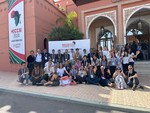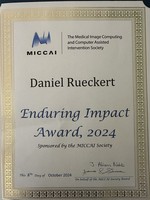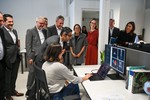About Us
The Lab for AI in Medicine at TU Munich develops algorithms and models to improve medicine for patients and healthcare professionals.
Our aim is to develop artificial intelligence (AI) and machine learning (ML) techniques for the analysis and interpretation of biomedical data. The group focuses on pursuing blue-sky research, including:
- AI for the early detection, prediction and diagnosis of diseases
- AI for personalised interventions and therapies
- AI for the identification of new biomarkers and targets for therapy
- Safe, robust and interpretable AI approaches
- Privacy-preserving AI approaches
We have particularly strong interest in the application of imaging and computing technology to improve the understanding brain development (in-utero and ex-utero), to improve the diagnosis and stratification of patients with dementia, stroke and traumatic brain injury as well as for the comprehensive diagnosis and management of patients with cardiovascular disease and cancer.
News
Key Publications
Metadata-enhanced contrastive learning from retinal optical coherence tomography images.
Reconciling privacy and accuracy in AI for medical imaging.
Evaluating and mitigating limitations of large language models in clinical decision making.
Unsupervised Pathology Detection: A Deep Dive Into the State of the Art.
Teaching
MSc Thesis: LLM/VLM-based AI Agents Workflow for Simplifying Medical Image Analysis
This project is collaborated with University of Oxford. Background: Building deep learning based medical image analysis pipelines can be a challenge for clinicians and medical science researchers due to the reliance on expertise with deep learning development, coupled with significant heterogeneity in real-world medical data and dynamic tasks centered at diverse research questions.
IDP/Thesis: Physics-based deep learning for hyperspectral neuronavigation
Hyperspectral imaging (HSI) is an optical technique that processes the electromagnetic spectrum at a multitude of monochromatic, adjacent frequency bands. The wide-bandwidth spectral signature of a target object’s reflectance allows fingerprinting its physical, biochemical, and physiological properties.
Master’s Thesis Opportunity: Differential Privacy for Interpretability
Introduction Understanding how machine learning models learn and organize concepts is a key challenge in interpretability research. This thesis investigates the potential of Differential Privacy (DP) as a constraint to analyze the hierarchical nature of concept learning, with the goal of improving model interpretability.
Master-Seminar: Implicit Neural Representation and Neural Fields (IN2107)
In this summer semester (2025S), we are offering a master’s seminar course on the topic of “Implicit Neural Representation and Neural Fields”. This seminar course will explore implicit neural representations (INR) and Neural Fields, an area of deep learning that uses neural networks to model complex functional mappings from coordinates to various field quantities such as radiance, image intensity, or density.
Deep Learning for Inverse Problems in Medical Imaging (IN2107)
Summer semester 2025. TUM Informatics. Master Seminar.
Vision-Language Pretraining for Bone Tumor Classification
Abstract: Bone tumor classification presents significant challenges due to the subtle visual differences among tumor entities, even for expert radiologists. This thesis aims to enhance diagnostic capabilities using vision-language pretraining to classify bone tumors from X-ray images.
MSc Thesis: Medial axis-based segmentation loss
Description Image segmentation seeks to classify individual pixels in an image into semantic classes, such as e.g. the organs in a CT scan. State-of-the-art approaches to image segmentation [5], while very accurate, have limitations in terms of topological correctness.
MSc Thesis: Large Language Models in Medicine
Description: Large Language Models (LLMs) have shown exceptional capabilities in understanding and generating human-like text. In the medical field, these models hold the potential to revolutionize patient care, medical research, and healthcare administration.
MSc Thesis: Outperforming CNNs and Transformers on Medical Imaging Tasks with Equivariant Networks
Description Equivariant convolutions are a novel approach that incorporate additional geometric properties of the input domain during the convolution process (i.e. symmetry properties such as rotations and reflections) [1]. This additional inductive bias allows the model to learn more robust and general features from less data, rendering them highly promising for application in the medical domain.
Master-Seminar: Multi-modal AI for Medicine (IN2107)
This year’s seminar will look at aspects of multi-modal machine learning in medicine and healthcare, focusing on: Vision language models (VLMs) for medical and healthcare applications Generic multi-modal AI models utilising imaging data, clinical reports, lab test results, electronic health records, and genomics Foundation models for multi-modal medicine Objectives: At the end of the module students should have:
Vacancies
We are recruiting team members who would like to join us for a MSc, BSc or guided research/interdisciplinary project on an ongoing basis! Please look under Teaching to find out which projects we are currently offering. If you’d like to join us for one of these projects, please get in touch by contacting the appropriate staff member via e-mail and attach a motivation letter, transcript of academic records and CV.
Current vacancies
Currently no positions are available.
Internships
Unfortunately we cannot host any external students for internships.




